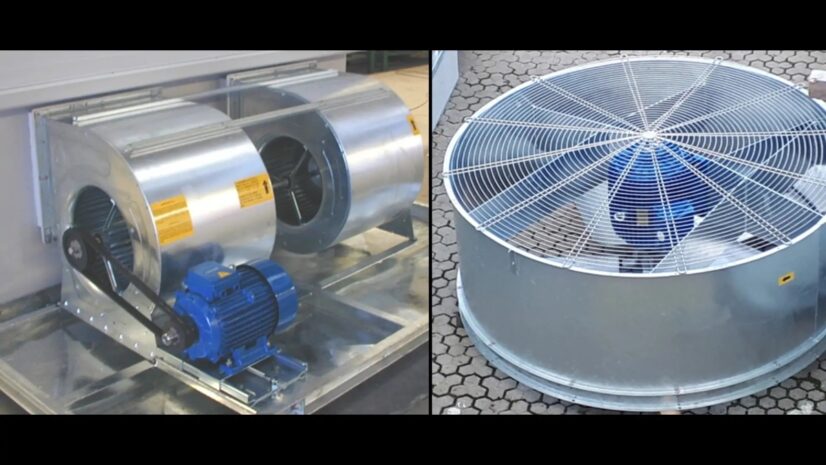Cooling Towers Today: Centrifugal or Axial Fan?

An attempt to answer this question must necessarily start from history and the origins of cooling towers, which are, to date, the most efficient and economic cooling system in existence.
—
by Giorgio Lorenzetti, Technical Advisor
Centrifugal cooling towers were overall conceived for civil application.
Being installed mainly on roofs, air conditioning systems with water-cooled condensers needed compact cooling units, possibly ducted in case they had to be positioned in air wells or limited spaces. However, most of all, they had to be silent or allow for the subsequent fitting of silencers, due to the presence of people in buildings such as offices, residential buildings, hotels and hospitals.
Compact centrifugal cooling towers were built by using fill packs with a large thermal exchange-specific surface and therefore high-density ducts. Air-in and air-out ducts were often fitted with elbows and reducers and also, whenever necessary, with splitter sound attenuators to reduce system noise when in function.
All of these aspects, connected to that specific type of installation, called for the use of a fan with both the airflow rate needed to guarantee the required thermal exchange and a medium to high static pressure, able to able to withstand the sum of the pressure drops in the whole air circuit.
Although characterised by rather low efficiency, the belt driven centrifugal fan long represented an ideal solution to this type of problem, in that its noise levels were more manageable due to the possibility of calibrating the number of revolutions based on need, by acting on the velocity ratio between pulleys.
Low efficiency was not /did not constitute a problem in itself because the use of the tower was mostly limited to the summer months.
For the opposite reasons to the ones illustrated above, axial cooling towers have instead been used mainly for industrial applications, where installation posed little or no problems of space while the noise factor, at least until recent years, was not subject to very strict regulations.
Considering the need to dissipate thermal power in much higher proportion than in civil systems, axial ventilators represented – and still do represent – an ideal solution to move high volumes of air efficiently and, therefore, with low energy consumption.
In recent years this sharp distinction in application has been significantly reduced, leading to challenges whenever a centrifugal cooling tower originally meant for civil use was installed in an industrial context (the fill pack tending to plug quickly, the pulleys needing frequent adjustment or substitution), or whenever a standard axial cooling tower was employed in a civil application, thus underestimating its acoustic impact.
The main providers of axial fans have undertaken to develop impellers with blades that have special edges, to reduce noise without seriously compromising performance. This surely represents an excellent starting point for cooling tower builders such as MITA Cooling Technologies.
To date therefore, although centrifugal cooling towers are still in use either for technical reasons or for compelling installation contingencies, the trend is surely towards axial fan solutions as these tend to be cheaper and require both lower electric power installed and less overall maintenance.
MITA Cooling Technologies has always focused its production on axial cooling towers and is now able to offer customised solutions for all industrial and civil applications, working on the entire configuration of the cooling tower.
The wide range of products available includes various solutions aimed at the industrial sector, as well as very low-noise solutions which are ideal for all those cases in which the acoustic factor is fundamental (such as hospitals, shopping malls, hotels, etc.)
Ask for InformationResources
Best practices
Read all Pieces of Advice by MITA Cooling TechnologiesWhat to Know
Find Out All Technical TermsTechnical Articles
Read All our Technical ArticlesNewsletter
Subscribe to MITA newsletter and stay updated on technical solutions for industrial and civil cooling and get to know our offer.